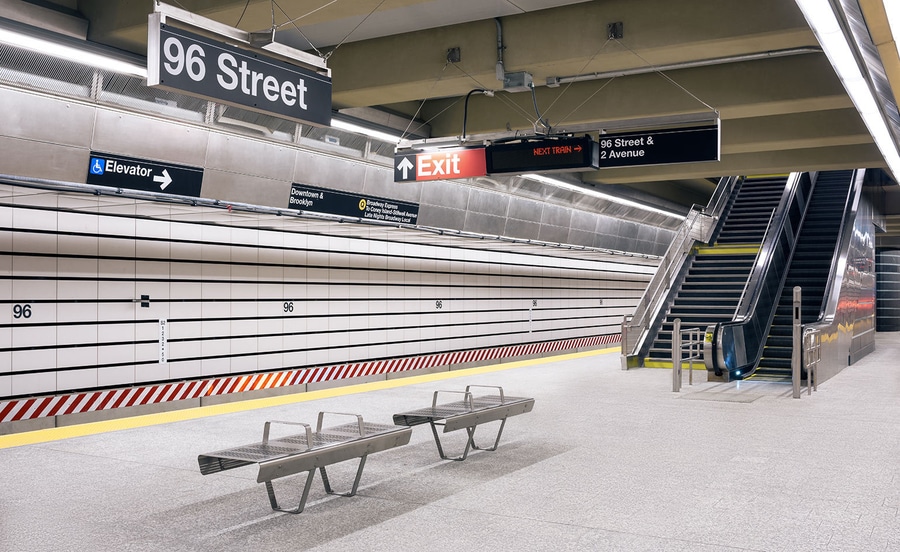
#LANDSCAPING AND URBAN PLANNING PROJECTS
AECOM-Arup completes the first phase of New York’s Second Avenue Subway expansion
The New York City Subway, which dates back to 1904, has reached a milestone in its expansion designed and engineered by AECOM-Arup Joint Venture. The first phase of the major expansion of the Second Avenue Subway is now complete with a new 1.8 mile stretch of track between 63rd and 96th streets, along with three new stations at 96th, 86th and 72nd streets, plus new entrances to the existing Lexington Avenue/63rd Street station.
As part of governor Andrew Cuomo’s transportation infrastructure improvement plans for the state, the $4.5 billion phase of expansion will increase accessibility to Manhattan’s East Side – reducing delays, relieving overcrowding on the Lexington line and adding step-free access from street to subway – improving the experience for 200,000 daily commuters.
Design, safety features and future-proofing have been incorporated into the complex project by AECOM and Arup. Finding a balance between form and function was important challenge for Julie D'Orazio, senior vice president and NY metro transit/rail Manager of AECOM, for this major project on one of the world’s oldest and most iconic subways. ‘We wanted to deliver an architecturally beautiful space that passengers would find visually stimulating and take pleasure in using. At the same time we had to ensure the design didn’t hinder the function of the station, getting riders to and from their destination with ease,’ she says.
The team generated dynamic pedestrian model simulations for all stations for the morning rush hour, which they used as a design tool to inform the optimal circulation paths for moving passengers between trains and the street level
Working to extend the existing NYC Subway system that had never been formalised in terms of design, the AECOM and Arup teams worked with New York City Transit Authority to devise a clear set of sustainable design guidelines that could be used for the future and incorporated rules for architectural detailing, ADA (Americans with Disabilities Act) compliance, spaces with high-ceilings, quality artwork and dramatic lighting, as well as parameters for improved safety and security.
The column-free design of the new platforms and mezzanine levels marked a change from the steel column and beam construction across the existing system. ‘It allows much better customer movement and visibility,’ says Arup principal Gillian Blake. ‘72nd Street and 86th Street are stations in rock caverns over 70ft wide and the curved nature of the supporting rock crown is expressed in the curved mezzanine ceilings. The customers can’t see all the engineering challenges that went into creating these spaces however I hope they appreciate the sense of openness,’ adds Blake.
Engineers led the excavation of spaces up to 1,591ft in length, some of the largest underground excavations in North America, while navigating the congested mass of telecommunications, electrical, gas, steam, water and sewage lines beneath New York using specialised skills from hydrology to geology.
Construction at Second Avenue Subway's 86th St cavern in 2014. Photography: MTA Capital Construction / Rehema Trimiew
Yet, the biggest challenge was connecting the old infrastructure to the new. ‘Retrofitting 63rd Street Station was the most complex part of the project,’ says Arup director and fellow David Caiden. ‘In many respects modifying an existing station is trickier than building a new one. Everything had to be accomplished with negligible service disruptions working behind hoardings that concealed things from the public.’
The close coordination of design engineers and construction professionals during the 15 year project, which broke ground in 2007, was the most important thing for D'Orazio. ‘This helps to streamline the build process, minimising the need to revise designs midway through,’ she says. ‘Today, design build procurements are much more effective because they are integrated and collaborative.’
Phase two of the expansion will extend the NYC Subway north and west from Second Avenue and E 96th Street to Lexington Avenue and E 125th St, and includes three new stations at 106th Street, 116th Street and 125th and Lexington Avenue, and eventually run 8.5 miles along the east side of Manhattan.

